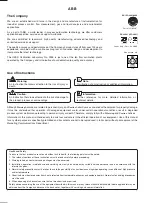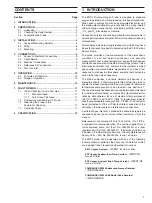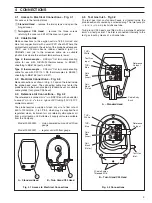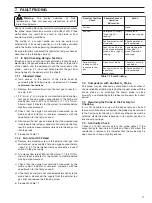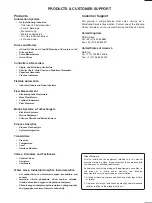
1
CONTENTS
1
INTRODUCTION
Section
Page
1
INTRODUCTION .............................................................. 1
2
PREPARATION ................................................................ 2
2.1
Unpacking ............................................................... 2
2.2
Checking the Code Number .................................... 2
2.3
Assembling the Probe ............................................. 2
3
INSTALLATION ................................................................ 4
3.1
Types of Measuring Systems .................................. 4
3.2
Siting ....................................................................... 6
3.3
Mounting .................................................................. 8
4
CONNECTIONS ............................................................... 9
4.1
Access to Electrical Connections ............................ 9
4.2
Cable Details ........................................................... 9
4.3
Electrical Connections ............................................. 9
4.4
Reference Air Connections ...................................... 9
4.5
Test Gas Inlet .......................................................... 9
5
OPERATION .................................................................. 10
5.1
Principles of Operation .......................................... 10
5.2
Range of Operation ............................................... 10
6
MAINTENANCE ............................................................. 10
7
FAULT FINDING ............................................................ 11
7.1
In Situ Checking Using a Test Gas ........................ 11
7.1.1
Standard Head ......................................... 11
7.1.2
Twin Gland C95 Head .............................. 11
7.2
Comparison with Another O2 Probe ...................... 11
7.3
Returning the Probe to the
Factory for Checking ............................................. 11
7.4
Continuity Check ................................................... 11
8
SPECIFICATION ............................................................ 12
The ZGP2 Zirconia Oxygen Probe is designed to measure
oxygen in oxidising, and some reducing, furnace atmospheres.
When used in conjunction with an appropriate electronics unit
the probe output voltage may be converted to a signal related
either to oxygen concentration, or oxidising potential, terms i.e.
%O
2
, ppmO
2
, kilocalories or millivolts.
Concentration terms are usually applicable to measurements in
oxidising atmospheres and potential terms are used for reducing
atmospheres.
Atmospheres which are strongly reduced, and which may have
free carbon present, are best monitored using the Z-CS2 Carbon
Sensor Probe.
The probe provides a true measurement of the atmospheric
conditions in situ and permits continuous and accurate
measurement over a wide temperature range without frequent
maintenance associated with external sampling systems. It also
eliminates ‘equilibrium shift’, common to other systems in which
gas samples are cooled before measurement, and has a fast
response to changes in atmosphere, enabling rapid corrective
action to be taken when necessary.
The probe comprises a ceramic detector cell housed in a
protective sheath. A thermocouple is fitted within the probe to
enable the process temperature to be monitored or for automatic
temperature compensation to be provided – see Section 5.1.
The sheath material is either aluminous porcelain (recommended
for oxidising atmospheres) or Incoloy 800 (recommended for
reducing atmospheres) for use at maximum temperatures of
1250
°
C (2282
°
F) and 1000
°
C (1832
°
F) respectively. Special
sheaths are available for use up to 1400
°
C (2552
°
F). A connector
head (protected to IP54 or IP56) facilitates connection of the
cell output, thermocouple and reference air connections.
A calibration gas inlet port is provided to enable the probe to be
checked using test gas mixtures without removing it from the
process.
Reference air, at a volume of 500 to 1000 ml/min. (1 to 2 ft
3
/hr),
is required for accurate operation. This can be supplied from a
mains-powered pump unit (Part No. 003000240) or a flow
regulator unit (Part No. 003000241), full details of which are
included in the Operating Instructions: Zirconia Reference Air
Supply Units – Part No. 003000239, Issue 1 onwards.
The ZGP2 probe can be operated with any of the following
instrumentation supplied by the Company, full details of which
are included in their respective Operating Instructions:
Z-MT Oxygen Analyzer
– IM/ZMT, Issue 5 or later
ZDT Oxygen Analyzer (Low Temp. Version)
– IM/ZDT/FG,
Issue 4 or later
ZDT Oxygen Analyzer (High Temp. Version)
– IM/ZDT/GP,
Issue 3 or later
COMMANDER SR100A Advanced Process Recorder
– IM/SR100APAK.
COMMANDER SR100B Multipoint Chart Recorder
– IM/SR100BPAK.


